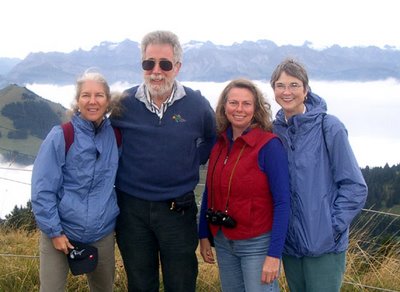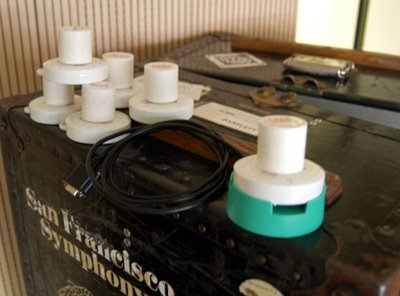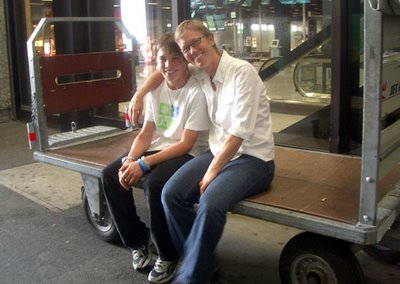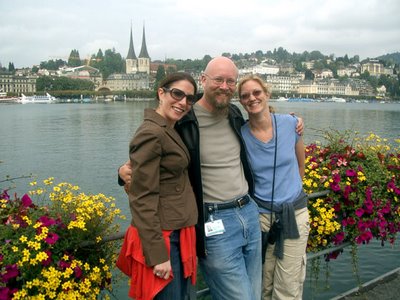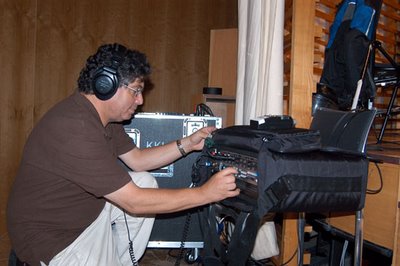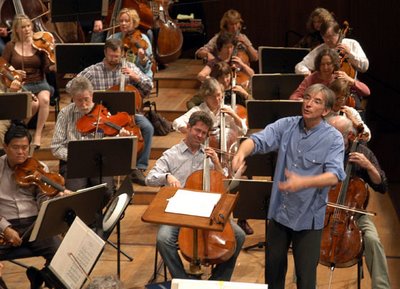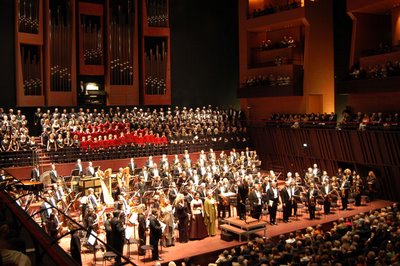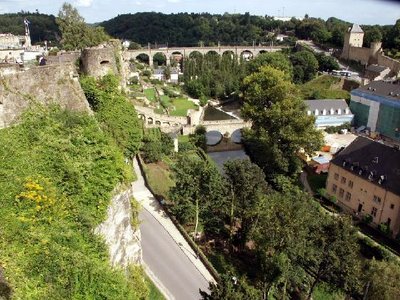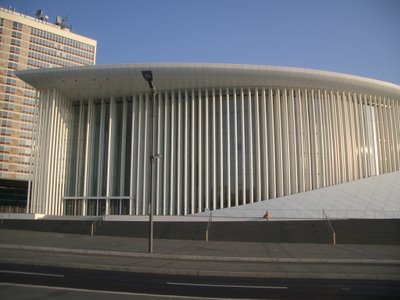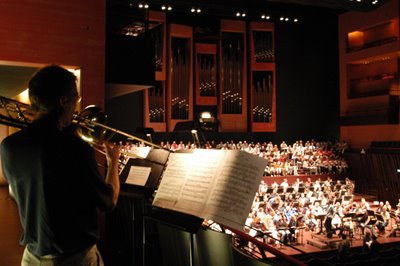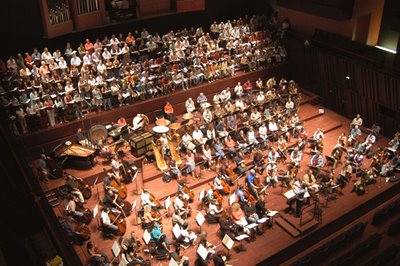The Lucerne Festival Finale
This group now knows this work well, but each concert hall poses its own acoustic and technical challenges, especially with a piece like Mahler’s 8th, with off-stage brass players and the angelic soprano, Laura Claycomb now perched 100 feet above the stage in the 4th balcony. During the rehearsal, the two sets of brass players needed to be moved from the fourth balcony down the second, as the sound is just not carrying as well from these heights. The operations team rushed to move the chairs, music stands and monitors (from which to watch the MTT cues) to get them in place. The other noticeable difference from the Luxembourg hall is the slightly smaller stage space, as the risers for the Boys Chorus now took up some valuable percussion section real estate. But all the kinks are worked out and everyone is anticipating the tour finale.

Utilizing every inch of stage space in the KKL for Mahler's 8th
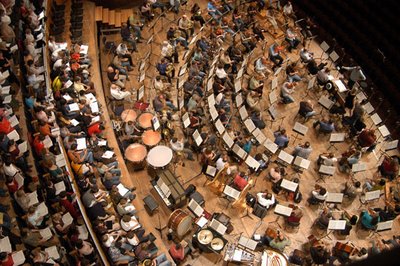
Can you spot your favorite SFS Orchestra member?

Now that's what I call offstage brass...the SFS horn section hanging out on the KKL rooftop terrace after the rehearsal
Today performance of Mahler's 8th was not your ordinary Sunday afternoon matinee. Not only was the concert closing the Festival (a big honor), but it will also be broadcast on national radio station DSR2. Microphones are everywhere to capture every nuance of the multilayered soundscape that this work produces. The crowd filled the lobby with great anticipation, many in black tie for the festival conclusion. As I sat in the Box Office lobby, sorting out today's tickets for orchestra guests and tour vip's, I attracted quite a bit of attention with my stack of valuable tickets, as I was interrupted by a half dozen eager patrons who asked me if I were selling any of my tickets. Seems that even the scalper's didn't have any for today. Now that's sold out ! From across the lobby, I saw a tall gentlement frantically waving trying to get my attention....great, another one desparate for tickets. I was right on the ticket part, but this local in need of a seat was Tom Hampson, the world renowned Baritone who had carpooled to Lucerne with the Zurich Opera Director to hear the performance. He is in Zurich singing Busoni's Faust. Davies Symphony Hall audiences can hear Tom Hampson in Mahler's Songs from Des Knaben Wunderhorn in May 2007, the performances of which will be recorded for SFS Media's ongoing Mahler cycle. Hard to refuse such a loyal fan, I gave Tom my seat and he was beaming as he ran in for the concert.
And what a concert it was. If you haven't heard Mahler's 8th Symphony performed live, you are definitely missing out. It is one of those magical musical journeys that has you smiling, in goosebumps, if not in tears (and as in Luxembourg, our two sopranos on stage teared up at the end, overcome by the sheer beauty of the 300 voices of the chorus and orchestra behind them.) It's easy to understand, I can only imagine standing right in the middle of this glorious sound that must hit them in every fiber of their being. The audience went wild. The usually reserved Swiss jumped to their seats and cheered the ensembles for a solid 5 minutes. Having had the honor of openening Luxembourg's concert season and now closing the festival in Lucerne, both with Mahler's 8th, our tour comes to a satisfied end. Everyone is all smiles as they know it was a special night. And one special thank you to someone who could not be here tonight, longtime SFS patron Gordon Getty, whose love of Mahler made this extraordinary project of bringing Mahler's Symphony of a Thousand to Europe possible financially. It was a huge undertaking on many levels, but one that proved an extraordinary artistic and cultural success.
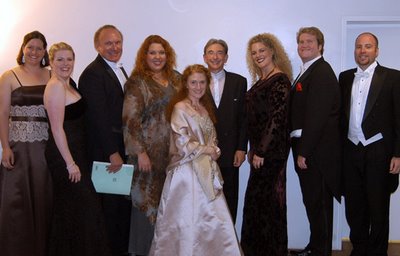
All smiles after Mahler 8. The cast with MTT

Baritone Tom Hampson congratulates SFS harpist Doug Rioth. Backstage, Tom was overheard calling Doug "the best harp player in the world".... we think so too, Tom.

End of tour also means saying goodbye to English Horn Player Julie Ann Giacobassi, who is retiring after 25 exceptional years in the orchestra. This was her final concert with the SFS.
It's still early evening in Lucerne (I love these 5pm concerts) as I walked past a CD store and spot our new Mahler 5 recording, and I was reminded of a story from a few days back. French horn players Bob Ward and Jonathan Ring were packing up backstage after the Luxembourg concert when a local gentlemen approached him with a big stack of CDs. The gentleman was a horn professor at the local music school, and the stack of CD’s was the SF Symphony’s Mahler recordings. The entire cycle. He asked to speak to Bob and the entire horn section, and proceeded to tell them that he owns recordings of all the great Mahler cycles…Berlin, Chicago…but he thought the San Francisco Symphony’s recordings topped them all. He came to hear the Mahler 8 and wanted the entire section to sign each of his discs. Now, mind you…the orchestra is usually on a pretty tight schedule after a concert, but it’s pretty tough to refuse something like that. He left with signatures and he left happy.

Jonathan Ring and Bob Ward (seated) practicing Mahler
Speaking of Bob Ward….he kindly offers this special Guest Blogging entry about touring abroad from an Orchestra member’s perspective:
It's a different sort of experience being on tour - at home we all have our personal lives and when the concert or rehearsal is over, we head back home to see our families and friends. On tour, we are a more cohesive lot. When not playing, we’re wandering the cities in small groups in search of interesting museums, shopping, sights and sounds. Oh, right - restaurants too...
There are challenges at the concerts that we as a group have to accept - new acoustics, for one. Every time we get to a different hall, we have to adjust, individually and as a group. A less reverberant hall means we have to warm up our sounds and play things a bit longer and more connected in order to create a sense of smoothness in the sustained passages - in a boomy acoustic, playing shorter and lighter helps the inner voices be clearer to the audience. And we have to make this adjustment in about the first 2-3 minutes that we start playing the concert. Even with a rehearsal we are sometimes surprised by a hall at the concert, since the addition of an audience can radically change the way a hall responds. In a certain sense, not only are we each playing our instruments, but we are collectively playing the hall as well.
I have been a member of the orchestra for 26 years, and at the end of each tour that we have taken, I always feel that we have accomplished something special. It's wonderful to make connections with new audiences, perform at a high level, and show the folks in different cities why I think we are a wonderful group with greatly talented players. And a lot of that feeling we can bring home with us to San Francisco. I often think how incredibly fortunate I am to have landed in San Francisco as a 24 year old, and how much I have grown as a musician in those 26 years.
Bob is absolutely right. We have accomplished something very special on this tour. To our knowledge, no American orchestra has toured with Mahler's 8th in Europe and, in my humble opinion, none could do it better. The reactions of the audience, the press, and the presenters have all been singularly positive, reaffirming the artistic reputation of the San Francisco Symphony as one of the very special orchestras around.
Thank you for joining us on our one week tour of Europe. It's been a pleasure bringing the sights and sounds of tour to those back home and beyond. See you in Davies Symphony Hall or perhaps in your hometown on tour.



